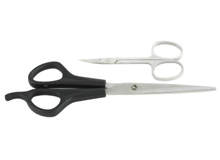
Millions of MRI examinations are performed safely each year, but there are risks. These include contrast agent toxicity (for example, nephrogenic systemic fibrosis), which may have affected several hundred patients, unsafe implants and devices perhaps having affected several dozen patients, and projectile injuries affecting a small number of patients and personnel.
It is the sudden and dramatic effects of projectiles that create the greatest failures of MRI safety policy compliance. In 1999, Chaljub and colleagues surveyed 250 US imaging facilities regarding the occurrence of MRI-related projectile accidents.
52% of respondents reported projectile events, including a defibrillator, wheelchair, respirator, ankle weights, an IV pole, toolbox, sandbags with metal pellets, a vacuum cleaner, and mop buckets. Even unimposing objects such as pens, scissors and paper clips present dangers.
The majority of such projectile events result in no injury to patients or personnel, however, in one unusual event, an off-duty policeman carried his semi-automatic pistol into a 1.5T magnet room where he was to be scanned. The weapon's thumb safety was reportedly engaged.
He had placed the weapon on a cabinet 0.9m from the magnet opening where it was pulled from his hand into the magnet. The weapon spontaneously discharged a round into the wall of the room at the rear of the magnet, where no one was injured.
See Also:
Costs of removal
How well do you really know your competitors?
Access the most comprehensive Company Profiles on the market, powered by GlobalData. Save hours of research. Gain competitive edge.

Thank you!
Your download email will arrive shortly
Not ready to buy yet? Download a free sample
We are confident about the unique quality of our Company Profiles. However, we want you to make the most beneficial decision for your business, so we offer a free sample that you can download by submitting the below form
By GlobalDataAttempts to physically remove attracted objects are difficult and dangerous. Often, several workers are required to remove even small objects. Sudden movement during extraction can cause personnel injury. At times, wrench assistance is required. Typically in such situations, the magnet will be required to be ramped down or quenched to remove the attracted object. Cryogen replacement for this process can cost up to $20,000. Scanner repairs and lost scanner revenue associated with MRI projectile accidents may increase expenses to $250,000 or more.
Gas cylinders are a particular risk in the MRI environment. Such cylinders can weigh from 30lb to 150lb when full. Ferromagnetic gas cylinders are especially dangerous in a magnetic environment, where they can be uncontrollably accelerated. Potential hazards include gas-propulsive missile impaction, explosion and fire. If the cylinder regulator valve is damaged on initial impact, the cylinder may propel away from the magnet, only to return for a second impact.
Patients and personnel are at great risk in such events. Often, the patient is sedated or under general anaesthesia. Attendant personnel are typically unfamiliar with the MRI milieu, where ferromagnetic objects may unknowingly be introduced into the magnetic field. For example, an oxygen tank may be hidden in the patient's bed sheets.
Based on the known risks of ferromagnetic cylinders, the safety programme for gas tanks in the MR environment includes procedures and training in the appropriate handling of cylinders and their exclusion from magnetic attraction. Many sites use in-line gas ports to avoid mobile oxygen cylinders entirely. Aluminium cylinders are an alternative solution. Because of the possibility of an erroneous cylinder exchange, it is best to secure all cylinders to the ground.
A 60-year-old man was awarded $100,000 in damages after sustaining facial fractures when he was struck by a size H oxygen cylinder while undergoing an MRI examination. This cylinder is the largest tank available at 23.5cm in diameter and 129.5cm long.
A loaded H cylinder and trailer may weigh 165lb. In this case, the MR imaging warning sign attached to the door was not visible because the door was propped open. A delivery person arrived with the replacement H-cylinder tank, which he brought into the MR suite on a cart. The cylinder was placed approximately 20ft (6m) away from the 0.6T unshielded magnet. The magnetic force suddenly pulled the cylinder off the cart.
The cylinder hit the MR table and then the fibreglass front cowling of the magnet, and lodged in the centre of the bore of the magnet, above the patient, with the safety shield portion of the tank against the patient's jaw. The MR technologist was unable to quench the magnet. Because the quenching apparatus failed, three radiology staff members finally extracted the patient through the opposite end of the magnet with great difficulty.
A fatal MR oxygen-cylinder accident was reported in 2001 when a six-year old sedated child was struck in the head by a ferrous oxygen canister. Apparently, an anaesthetist brought the cylinder into the magnet room while the two MRI technologists focused on another problem.
An autopsy conducted by the Westchester County Medical Examiner confirmed that the patient had died of blunt force trauma, severe haemorrhaging and a contusion to the brain.
It is less well known that this event was preceded by an apparently similar non-fatal incident in 1997 at that same facility. Hospital staff members and officials were criticised for failing to report and investigate this non-injury oxygen cylinder missile event. An investigation by the New York Attorney General disclosed 11 safety violations leading to fines of $22,000.
Magnetic field strength
Magnetic field strength increases as the inverse cube of the distance from the magnet. Thus, moving from 20ft away from the magnet to 10ft away increases the magnetic field strength by a factor of 23=8. Self-shielded magnets have a more rapidly increasing magnetic field, so ferromagnetic objects are more likely to be suddenly drawn towards the magnet. Of course, higher field strength 3T magnets exert double the force of 1.5T magnets (Figure 1).
The great force exerted by a 1.5T magnet is demonstrated in Figure 2, where a heavy steel dog lead is held horizontally by the magnetic field. Metallic objects may reach velocities greater than 40mph. The destructive potential of this magnetic force is shown in Figure 3, where a floor buffer has been violently attracted to a 1.5T magnet with extensive penetration into the magnet cowling.
Uninformed personnel visiting the MRI centre pose additional risks for the introduction of ferromagnetic objects into the magnetic environment. Maintenance workers, police, firefighters, visiting physicians and other attending medical personnel present the greatest risk for breaches of MRI safety policies. In most MRI accidents, participants did not appreciate the suddenness of the great forces involved and were unaware that the superconducting magnet is always on.
With proper precautions, the risk of MRI projectile incidents can be reduced through the following measures:
- appropriate safety training and vigilance by MRI schedulers, coordinators and technologists
- well placed, appropriate warning signage, such as: 'Danger! This magnet is always on.'
- appropriate physical barriers including locking doors to the inner scanner areas
- appropriate MRI centre design to allow for ACR recommended MRI safety zones
- centre policies covering areas such as:
- personnel safety training
- active safety zone policies and signage
- exclusive use of MRI safe wheelchairs, gurneys, monitors, gas canisters and IV poles
- patient and visiting personnel screening forms
- conventional hand-held and zone screening metal detectors, which may be helpful, but are occasionally unreliable.
Effective warnings
The importance of effective signage and physical barriers cannot be overemphasised. Signage must state that 'the magnet is always on'. Illustrative signage is very helpful, especially for personnel and visitors with language limitations. Wall, floor and free-standing signage may be helpful because door signage may be unapparent on open doors. Properly designed MRI suites with appropriate hierarchical zonal protections and barriers (Table 1) help to prevent mishaps.
Entrance to 'Zone IV', the magnet room, should be strictly limited to prescreened patients, visitors and trained professionals.
All such MRI projectile events represent sequential failures of safety layers (Figure 4) extending from institutional and centre policy to the actions of schedulers, coordinators, technologists, as well as patients and their friends and families.
MRI projectile incidents will always represent a great risk to patients and personnel. Potential ferromagnetic objects from hairpins to gas cylinders should be excluded from the MR magnet room. Appropriate policies and vigilance at all levels can preserve the safety of the MRI environment.




